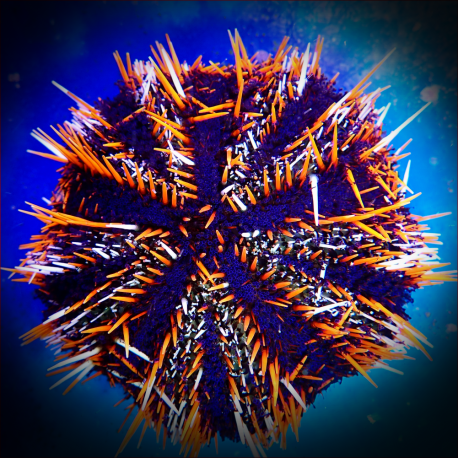More info
Datasheet
| Minimum Tank Size | 400 litres / 105.67 US gallons |
| Maximum Size | 15.0cm / 5.91inches |
| Reef Compatible | Often reef safe |
| Temperament | Peaceful |
| Temperature | 22.2°C / 71.96°F - 25.6°C / 78.08°F |
| Specific Gravity | 1.020-1.025 |
| Carbonate Hardness | 8-12 |
| pH | 8.1-8.4 |
General Description:The Collector Urchin, scientifically known as Tripneustes gratilla, belongs to the family Echinoidea. These sea urchins are commonly used to control algae in aquariums, devouring various types from coralline to green hair algae. They are known for their tendency to upend corals that are not securely affixed and move rocks in search of food.
Aquarium Suitability:With an average hardiness level, Collector Urchins are deemed suitable for aquariums of at least 400 liters. They are peaceful in temperament and are often considered reef safe, making them a potentially beneficial addition to marine tanks with the necessary algae for sustenance.
Care and Hardiness:Collector Urchins are relatively easy to care for but require a gradual acclimatization process due to their sensitivity to changes in salinity. They typically thrive in water conditions with a pH of 8.1-8.4, a specific gravity of 1.020-1.025, a temperature range of 22.2-25.6°C, and a carbonate hardness (KH) level of 8-12.
Reef Suitability:These urchins are often compatible with reef environments; however, precautions should be taken as they have a tendency to disrupt corals and other structures in their quest for food.
Aquarium Setup:When setting up an aquarium for Collector Urchins, it is important to include ample algae for their diet. Providing stable rock formations and ensuring that corals are securely attached can help mitigate disturbances caused by these active algae-eating creatures.
Behaviour:Collector Urchins exhibit a peaceful temperament in the aquarium. They are known to rearrange rocks and corals in their environment while foraging for algae, contributing to the overall dynamics of the tank.
Feeding and Diet:These urchins primarily feed on macroalgae such as seaweed or nori and microalgae like spirulina. Ensuring a steady supply of suitable algae is essential for their nutritional needs and overall well-being.
Habitat and Distribution:Collector Urchins, native to regions including the East Indian Ocean, West Indian Ocean, Australia, The Red Sea, Indonesia, and the East Pacific, are found widely across the Central and West Pacific. Their distribution reflects their adaptability to varying marine environments.

